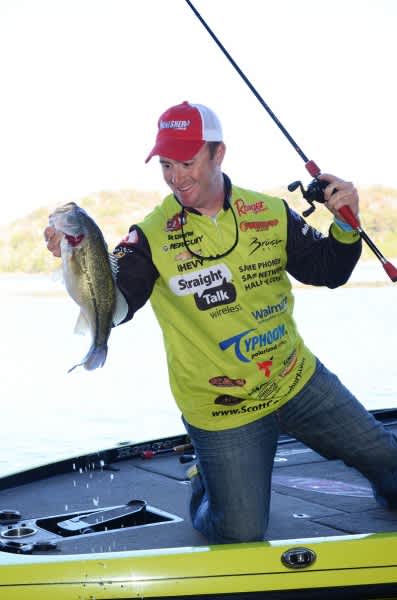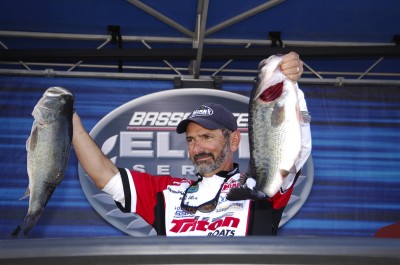Fishing the 50-degree Temperature Break: Buzzbaits and Jerkbaits
John E. Phillips 12.01.14

“Cast and retrieve” is a tactic that generally catches anglers the most bass, but not in the wintertime. During the winter months, the metabolism of bass slows down, and the fish want to expend as little energy as possible to catch and eat big baits. Here are two different tactics to fish for bass this winter, depending on water temperature.
Buzz ‘em up
“In 2014, a technique that’s really been getting a lot of attention is fishing a buzzbait on the surface with a plastic frog behind it in areas where you have floating or scattered grass,” Scott Canterbury, a professional bass angler from Springville, Alabama, said. “Anytime the weather is above 50 degrees I’ll be throwing the buzzbait, even in January and February. I fish the buzzbait in the winter months, because it attracts big bass.”
Canterbury’s favorite place to fish the buzzbait is any place there’s vegetation and wood. “For instance, if the grass is dying off and floating to the surface, it often will blow up against logs or limbs,” Canterbury explained. “I’ll throw the Punisher buzzbait, since it has a longer wire going to the hook than most buzzbaits and a bait keeper type device in front of the hook. Then I can put a rubber frog, a swimbait, or another soft plastic lure behind the buzzbait. When I rig like this, I give the bass a better target to look at than just a skirt. Also, placing a soft plastic lure behind a buzzbait means you can cast the buzzbait farther and better with the additional weight. With a solid body on the back of a buzzbait, I also feel like the bass will get more of the bait in its mouth than when the buzzbait only has a skirt.”
Canterbury finished second in the FLW Forrest Wood Cup twice using the buzzbait with a soft plastic trailer. Canterbury recommends having the soft plastic under the water when you retrieve it. Then the bass doesn’t have to break the water to take the lure but rather can suck the body of the buzzbait into its mouth while staying underwater.
One of Canterbury’s favorite ways to fish the buzzbait in cold water is to skip it under boat docks and then start the retrieve. “I can skip a buzzbait 30 feet back under a dock, if I have a soft plastic body like a frog or swimbait behind the buzzbait,” Canterbury mentioned. “Sometimes I can’t see the buzzbait but only can hear it. I set the hook when I hear or feel the bass strike. If the bass won’t take a frog, I’ll switch to using a swimbait behind the buzzbait, and the bass will take that.”

Jerk ‘em up
Paul Elias of Laurel, Mississippi, a former Bassmaster Classic winner, said, “When the water temperature is in the 50s, I’ll reel the jerkbait down to five or seven feet, stop the bait, let it suspend for a count of one Mississippi, two Mississippi, and three Mississippi, jerk it, allow it to stop and suspend again, while I count through three Mississippis before jerking once more. Once the water temperature drops into the 40s, I’ll stop the bait and let it suspend motionless for a count of 10, if I can wait that long.”
Most bass anglers often feel if their lures aren’t moving, they’re not attracting the attention of the bass. That’s why dead sticking (letting the lure sit still in the water and not giving it any action at all) is tough for bass fishermen. A lure sitting still in the water is one of the most natural presentations you can make to a fish to get it to bite, especially if it doesn’t want to bite. If you watch fish in an aquarium, you’ll often see that they sit dead still and don’t move. If you watch minnows in a minnow tank, they’ll suspend in mid-water and not move, especially in cold water. A bass watching a bait fish sitting still in the water only has to move slowly up in the water column, come up behind the bait fish, open its mouth and suck in the bait fish. A jerkbait is one of the most deadly lures for a bass fisherman to use in cold weather, because once it’s five to seven feet under the water and then suspended to a count of 10, the bass can move up to the jerkbait and suck in the lure. All you’ll see is your line twitch. Fishing the jerkbait is a slow tactic to catch bass off points, off underwater weed lines, over underwater ledges and around concrete dams and locks.
“I like a black back, silver sided or a shad patterned jerkbait,” Elias says. “I put a six- to eight-foot leader of eight-pound test fluorocarbon line on the jerkbait, attach 14-pound test Berkley braided main line and use a medium action Pinnacle spinning rod and reel. I make long casts, get the jerkbait down to the strike zone of the bass, and let it suspend. The colder the weather is, the longer you need to let the jerkbait sit motionless before you move it again. I’ll only give it two or three quick jerks, causing it to move only about one to 1-1/2 feet, and then let it suspend again. You’ll be surprised how many winter bass you can catch with this technique.”
Bet on the jerkbait when the water temperature is below 50 degrees, or when the water temperature’s above 50 degrees, use a buzzbait with a soft plastic lure in the winter to possibly catch a bass of a lifetime on these two lures.
For more tips and information on catching bass, check out John E. Phillips’ Kindle and print books Catch the Most and Biggest Bass in Any Lake, How to Bass Fish Like a Pro, and How to Win a Bass Tournament.

